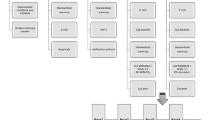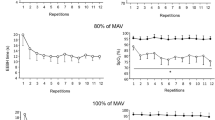Abstract
This study investigated whether in trained middle-distance runners, intermittent short-term graded running performance is affected by a hypobaric hypoxic environment (simulated 2,500 m) (H). Seven male middle-distance runners performed an aerobic performance test and an intermittent short-term graded anaerobic running-performance test (MART) both in H and in a normobaric normoxic environment (N). VO2max and OBLA were markedly lower (by 18.1% and 8.7%, respectively) in H than in N. In MART, neither maximal running velocity (Vmax) nor exhaustion-time was different between N and H (454 (7) m min−1 vs. 451 (6) m min−1, respectively, and 208.7 (5.2) s vs. 205.7 (4.2) s, respectively). The blood lactate concentration at sub-maximal running speed (425 m min−1) was significantly greater in H than in N (paired t-test: P<0.05). These results suggest that, in trained middle-distance runners, intermittent short-term graded running performance is not affected by H, despite a considerable decrease in aerobic power in H during the aerobic performance test.



Similar content being viewed by others
References
Balsom PD, Gaitanos GC, Ekblom B, Sjodin B (1994) Reduced oxygen availability during high intensity intermittent exercise impairs performance. Acta Physiol Scand 152: 279–285
Benoit H, Busso T, Castells J, Geyssant A, Denis C (2003) Decrease in peak heart rate with acute hypoxia in relation to sea level VO2max. Eur J Appl Physiol 90: 514–519
Brosnan MJ, Martin DT, Hahn AG, Gore CJ, Hawley JA (2000) Impaired interval exercise responses in elite female cyclists at moderate simulated altitude. J Appl Physiol 89:1819–1824
Calbet JAL, De Paz JA, Garatachea N, Cabeza de Vaca S, Chavarren J (2003a) Anaerobic energy provision does not limit Wingate exercise performance in endurance-trained cyclists. J Appl Physiol 94: 668–76
Calbet JAL, Boushel R, Radegran G, Sondergaard H, Wagner PD, Saltin B (2003b) Determinant of maximal oxygen uptake in severe acute hypoxia. Am J Appl Physiol Regul Integr Comp Physiol 284: R291-R303
Gavin TP, Derchak PA, Stager JM (1998) Ventilation’s role in the decline in VO2max and SaO2 in acute hypoxic exercise. Med Sci Sports Exerc 30:195–199
Gore CJ, Hahn AG, Scroop GC, Watson DB, Norton KL, Wood RJ, Cambell DP, Emonson DL (1996) Increased arterial desaturation in trained cyclists during maximal exercise at 580 m altitude. J Appl Physiol 80:2204–2210
Gore CJ, Hahn AG, Aughey DT, Martin DT, Ashenden MJ, Clark AP, Granham AD, Roberts AD, Slaters GJ, McKenna MJ (2001) Live high: train low increases muscle buffer capacity and submaximal cycling efficiency. Acta Physiol Scand 173:275–286
Houmard JA., Costill DL, Mitchell JB, Park SH, Chenier TC (1991) The role of anaerobic ability in middle distance running performance. Eur J Appl Physiol Occup Physiol 62:40–43
Ibanez J, Rama R, Riera M, Prats MT, Palacios L (1993) Severe hypoxia decreases oxygen uptake relative to intensity during submaximal graded exercise. Eur J Appl Physiol Occup Physiol 67:7–13
Julian CG, Gore CJ, Wilber RL, Daniels JT, Fredericson M, Stray-Gundersen J, Hahn AG, Parisotto R, Levine BD (2004) Intermittent normobaric hypoxia does not alter performance or erythropoietic markers in highly trained distance runners. J Appl Physiol 96:1800–1807
Kayzer B (2003) Exercise starts and ends in the brain. Eur J Appl Physiol 90: 411–419
Knuttgen HG, Saltin B (1973) Oxygen uptake, muscle high-energy phosphates, and lactate in exercise under acute hypoxic conditions in man. Acta Physiol Scand 87:368–376
Koistinen P, Takala T, Martikkala V, Leppaluoto J (1995) Aerobic fitness influences the response of maximal oxygen uptake and lactate threshold in acute hypobaric hypoxia. Int J Sports Med 16:78–81
Lacour JR, Bouvant E, Barthélémy JC (1990) Post-competition blood lactate concentrations as indicators of anaerobic energy expenditure during 400-m and 800-m races. Eur J Appl Physiol 61:172–176
Lawler J, Powers SK, Thompson D (1988) Linear relationship between VO2max and VO2maxdecrement during exposure to acute hypoxia. J Appl Physiol 64:1486–1992
Levine BD, Stray-Gundersen J (1997) “Living high- training low”: effect of moderate-altitude acclimatization with low-altitude training on performance. J Appl Physiol 83:102–112
Martin D, O’Kroy J (1993) Effects of hypoxia on the VO2max of trained and untrained subjects. J Sports Sci 11:37–42
McLellan TM, Kavanagh MF, Jacobs I (1990) The effect of hypoxia on performance during 30 s or 45 s of supramaximal exercise. Eur J Appl Physiol Occup Physiol 60:55–61
McLellan TM, Cheung SS, Meunier MR (1993) The effect of normocapnic hypoxia and the duration of exposure to hypoxia on supramaximal exercise performance. Eur J Appl Physiol Occup Physiol 66: 409–414
Newsholme EA (1986) Application of principles of metabolic control to the problem of metabolic limitations in sprinting, middle-distance, and marathon running. Int J Sports Med 7:S66-S70
Nummela A, Rusko H (2000) Acclimatization to altitude and normoxic training improve 400-m running performance at sea level. J Sports Sci 18:411–419
Nummela A, Alberts M, Rijntjes RP, Luhtanen P, Rusko H (1996a) Reliability and validity of maximal anaerobic running test. Int J Sports Med 17:S97–S102
Nummela A, Andersson N, Hakkinen K, Rusko H (1996b) Effect of inclination on the result of the Maximal Anaerobic Running Test. Int J Sports Med 17:S103–S108
Richardson RS (1998) Oxygen transport: air to muscle cell. Med Sci Sports Exerc 30:53–59
Robergs RA, Quintana R, Parker DL, Frankel CC (1998) Multiple variables explain the variability in the decrement in VO2max during acute hypobaric hypoxia. Med Sci Sports Exerc 30:869–879
Rusko H, Nummela A (1996) Measurement of maximal and submaximal anaerobic performance capacity: concluding chapter. Int J Sports Med 17:S125–S129
Rusko H., Nummela A, Mero A (1993) A new method for the evaluation of anaerobic running power in athletes. Eur J Appl Physiol Occup Physiol 66:97–101
Saltin B, Kim CK, Terrados N, Larsen H, Svedenhag J, Rolf CJ (1995) Morphology, enzyme activities and buffer capacity in leg muscles of Kenyan and Scandinavian runners. Scand J Med Sci Sports 5:222–230
Spencer MR, Gastin PB (2001) Energy system contribution during 200- to 1500-m running in highly trained athletes. Med Sci Sports Exerc 33: 157–162
Squires RW, Buskirk ER (1982) Aerobic capacity during acute exposure to simulated altitude, 914 to 2286 meters. Med Sci Sports Exerc 14:36–40
Svedenhag J, Saltin B, Johonson C, Kaijeser L (1991) Aerobic and anaerobic exercise capacities of elite middle-distance runners after two weeks of training at moderate altitude. J Med Sci Sports 11:205–214
Takase K, Nishiyasu T, Asano K (2002) Modulating effects of the menstrual cycle on cardiorespiratory responses to exercise under acute hypobaric hypoxia. Jpn J Physiol 52:553–560
Tanaka K, Matsuura Y, Kumagai S, Matsuzaka A, Hirakoba K, Asano K (1983) Relationships of anaerobic threshold and onset of blood lactate accumulation with endurance performance. Eur J Appl Physiol Occup Physiol 52:51–56
Truijens MJ, Toussaint HM, Dow J, Levine BD (2003) Effect of high-intensity hypoxic training on sea-level swimming performances. J Appl Physiol 94: 733–743
Vuorimaa T, Häkkinen K, Vähäsöyrinki P, Rusko H (1996) Comparison of three maximal anaerobic running test protocols in marathon runners, middle-distance runners and sprinters. Int J Sports Med 17: S109-S113
Weyand PG, Lee CS, Martinez-Ruiz R, Bundle MW, Bellizzi MJ, Wright S (1999) High-speed running performance is largely unaffected by hypoxic reductions in aerobic power. J Appl Physiol 86:2059–2064
Williams JH, Powers SK, Stuart MK (1986) Hemoglobin desaturation in highly trained athletes during heavy exercise. Med Sci Sports Exerc 18:168–173
Acknowledgments
We are grateful to the University of Tsukuba track-and-field middle distance team for participation in this study as subjects. We also greatly appreciate the help of Dr. Robert Timms (English editing and critical comments). This study was supported by grants from University of Tsukuba Research Projects, COE projects, and the Ministry of Education, Science, and Culture, Japan.
Author information
Authors and Affiliations
Corresponding author
Rights and permissions
About this article
Cite this article
Ogawa, T., Ohba, K., Nabekura, Y. et al. Intermittent short-term graded running performance in middle-distance runners in hypobaric hypoxia. Eur J Appl Physiol 94, 254–261 (2005). https://doi.org/10.1007/s00421-005-1322-7
Accepted:
Published:
Issue Date:
DOI: https://doi.org/10.1007/s00421-005-1322-7




